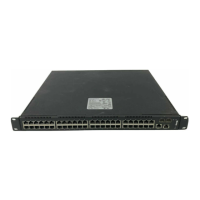Layer 2,3,IPv6+QoS Switch
_____________________________________________________________________________
Layer 2,3,IPv6+QoS Network Switch User Manual Version 0.1 Page: 789/970
11.2.3.3.1. Configuring OSPF
Configurable Data
Router ID - The 32 bit integer in dotted decimal format that uniquely identifies the router
within the autonomous system (AS). If you want to change the Router ID you must first
disable OSPF. After you set the new Router ID, you must re-enable OSPF to have the
change take effect. The default value is 0.0.0.0, although this is not a valid Router ID.
OSPF Admin Mode* - Select enable or disable from the pulldown menu. If you select
enable OSPF will be activated for the switch. The default value is disable. You must
configure a Router ID before OSPF can become operational. You do this on the IP
Configuration page or by issuing the CLI command: config router id.
*NOTE: once OSPF is initialized on the router, it will remain initialized until the
router is reset.
RFC 1583 Compatibility - Select enable or disable from the pulldown menu to specify
the preference rules that will be used when choosing among multiple AS-external-LSAs
advertising the same destination. If you select enable, the preference rules will be those
defined by RFC 1583. If you select disable, the preference rules will be those defined in
Section 16.4.1 of the OSPF-2 standard (RFC 2328), which will prevent routing loops
when AS-external-LSAs for the same destination have been originated from different
areas. The default value is 'enable'. To prevent routing loops, you should select 'disable',
but only if all OSPF routers in the routing domain are capable of operating according to
RFC 2328.
Exit Overflow Interval (secs)- Enter the number of seconds that, after entering overflow
state, the router should wait before attempting to leave overflow state. This allows the
router to again originate non-default AS-external-LSAs. If you enter 0, the router will not
leave Overflow State until restarted. The range is 0 to 2147483647 seconds.
SPF DelayTime(secs) - Enter the number of seconds, Delay time (in seconds)is the time
between when OSPF receives a topology change and when it starts an SPF calculation.
It can be an integer from 0 to 65535. The default time is 5 seconds. A value of 0 means
that there is no delay; that is, the SPF calculation is started immediately.
SPF HoldTime(secs) - Enter the number of seconds, minimum time (in seconds)
between two consecutive SPF calculations.It can be an integer from 0 to 65535. The
default time is 10 seconds. A value of 0 means that there is no delay; that is, two SPF
calculations can be done, one immediately after the other.
Default Metric - Sets a default for the metric of redistributed routes.This field displays the
default metric if one has already been set or blank if not configured earlier. The valid
values are (1 to 16777215)
Maximum Paths - Sets the maximum number of paths that OSPF can report for a given
destination. The valid values are (1 to 6).
Default Information Originate - Enable or Disable Default Route Advertise.

